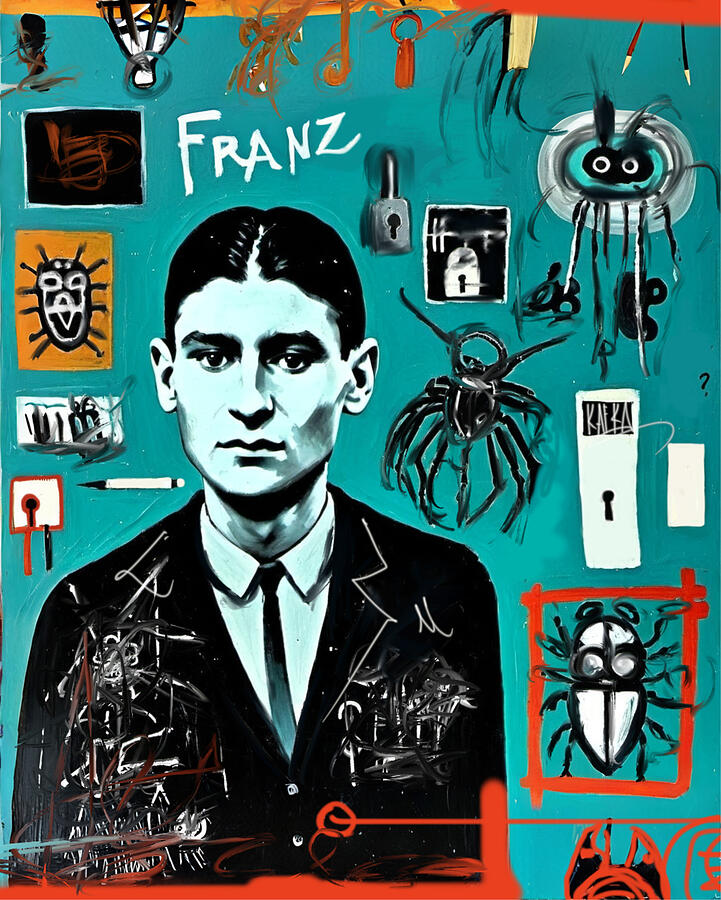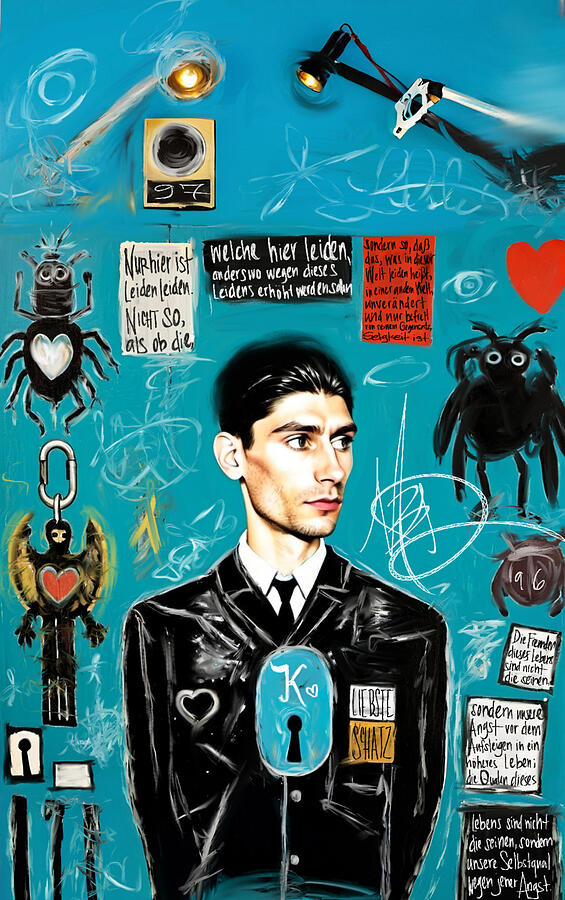M.B. Dallocchio
Year of birth: 1981.
Where do you live: Milan, Italy.
Your education: Bachelor of Science in Political Science & Master of Social Work (MSW) from USC.
Describe your art in three words: Transformative, evocative, resilient.
Your discipline: Mixed media, digital, acrylic, gouache, graphite, and ink.
Website | Instagram
Your work draws on the themes of trauma, the Military-Industrial Complex, and intersectionality. Can you tell us how your personal experiences as a soldier have influenced your art?
My time as a soldier shaped not only the way I see the world but also how I experience it. The things I witnessed, both inspiring and tragic, deepened my awareness of the fragility and resilience of humanity. Military life exposed me to the machinery of power—the Military-Industrial Complex—and the Kafkaesque human toll it takes in perpetuating cycles of war and exploitation on behalf of wealthy individuals, Defense contractors, and the politicians being paid for by both. My experiences pulled back the veil on systems that often treat people as expendable, and this dissonance between the human and the systemic profoundly impacts my art.
Through my work, I process the trauma of childhood through military service—both seen and unseen. I explore the emotional terrain that marks a person forever, whether it’s moral injury, survivor’s guilt, or the struggle to find yourself again in a community that cannot fathom the realities of war. Art becomes a language for me to translate these experiences, a way to articulate the unspeakable and invite others to confront the shadowed corners of their own worlds.
How do you approach the concept of life as performance in your art? What role does transformation play in the way you explore human experiences?
Life is, in many ways, an ongoing performance. Each of us moves between our roles—the soldier, the healer, the artist, the parent—all while balancing the self within the constraints of societal expectations. My art plays in that liminal space, where the mask we wear blurs into the truth underneath. Performance in my work isn’t about deception but adaptation. Humans are constantly improvising to survive, and within that improvisation, there’s the metamorphosis.
Transformation is central to my practice because it reflects the human condition. Our experiences can break us, but they can also remold us into something stronger, wiser, or gentler. This dynamic is evident in my work as I overlay various textures with high contrasting colors, reflecting how fragility persists despite systemic hardness. I invite viewers to explore their own layers of identity, to grapple with the ways they’ve adapted, and to consider what moments in life have reshaped them—for better or worse.
 M.B. Dallocchio | Franzl
M.B. Dallocchio | Franzl
Your statement mentions using artistic alchemy to transmute tragedy into inspiration. Could you elaborate on the process you go through to achieve this transformation in your work?
Artistic alchemy, to me, is about taking life’s darkest experiences and distilling them into something meaningful, if not beautiful. It’s less about erasing pain and more about giving it a purpose. My process begins with honesty—I allow myself to confront those moments of deep anguish or frustration, whether it’s tied to trauma, loss, or the chaos of the world. From there, I extract elements of those emotions and reimagine them in a form that others can engage with.
For example, I might use objects associated with violence or obstruction but present them in a way that speaks to resilience or rebirth. This transformation isn’t a linear process. It’s often messy and requires revisiting painful memories, reshaping them until they feel less like weights and more like lessons. The goal is to create work that acknowledges sorrow but doesn’t resign to it, offering instead a sense of shared humanity and healing.
Franz Kafka and Frida Kahlo have been major influences on your art. How do their works resonate with you and find expression in your creations?
Kafka and Kahlo both reveal truths about existence that resonate deeply with me. Franz Kafka’s exploration of alienation, bureaucracy, and the grotesque mirrors some of my own experiences within institutions like the military. His sense of the surreal and absurd creeping into everyday life parallels my own fixation with the “unreality of the human condition.” I often use distorted or fragmented imagery in my art to reflect how our inner worlds clash with external systems.
Frida Kahlo, on the other hand, lays bare the personal. Her work is unapologetically vulnerable, turning pain into an intimate, visceral experience. I draw strength from her ability to visualize suffering as both deeply personal and inherently universal. She inspires me to weave my own bodily and emotional experiences with larger sociopolitical themes, creating art that speaks to both the individual and the collective.
 M.B. Dallocchio | Letters to Milena
M.B. Dallocchio | Letters to Milena
In your work, you also blend your experience as a social worker with your artistic practice. How do you balance these two aspects, and how do they inform each other?
Being a social worker taught me to hold space for others’ suffering while recognizing the systemic forces at play in their lives. This practice of empathy and analysis carries into my art. Social work involves listening deeply and seeing people not as isolated beings but as interconnected with their environment, history, and identity. Similarly, my art speaks to intersectionality and positionality—where personal stories meet societal issues like trauma, war, or inequality.
Balancing both roles is not without its challenges, as both demand emotional energy. However, they feed into one another in meaningful ways. Social work keeps me grounded in real human experiences, while art offers a more abstract, reflective space to explore and process those realities. At their core, both practices share the same purpose—healing and finding meaning in one’s own journey.
You mention your fascination with the “unreality of the human condition.” How does this notion manifest in the textures and themes of your artwork?
The unreality of the human condition, for me, is about the dissonance between what we perceive as real and the deeper, often hidden truths of our existence. Life is fleeting and unpredictable, yet we cling to illusions of permanence and control. This tension finds its way into the textures of my art—juxtapositions between hard-edged industrial elements and more ephemeral, organic forms represent the push-pull between clarity and chaos.
Thematically, I explore the layers of human experience that feel real yet surreal—our emotions, memories, and the stories we tell ourselves to make sense of them. This shows up in imagery that’s fractured or slightly warped, reflecting how our perceptions rarely align perfectly with reality. My work ultimately invites viewers to question what is “real” within their experiences and encourages them to sit with the discomfort of not finding a single, easy answer.
 M.B. Dallocchio | The Paradox of Pain
M.B. Dallocchio | The Paradox of Pain
Your projects explore the pathways to healing from complex trauma. Could you share how your artwork acts as a tool for healing both for you and for your audience?
Creating art is a deeply cathartic process for me. It allows me to channel emotions that might otherwise feel overwhelming into something tangible—something I can examine, manipulate, and eventually transform. This act of creation is inherently healing because it reminds me that pain is not static. My work demonstrates that trauma can evolve into a narrative—not one that defines you, but one that helps you transcend.
For my audience, I hope my artwork serves as a mirror. By being vulnerable in what I create, I want to offer others permission to confront their own pain and histories. Many viewers have shared how my work helped them process their emotions or simply feel less alone. The universality of symbol and texture in my art intends to create a shared space where healing becomes a collective, rather than isolating, experience. Healing, after all, is not a destination—it’s an ongoing process, and my art offers a hand to those walking that path.

Leave a Reply